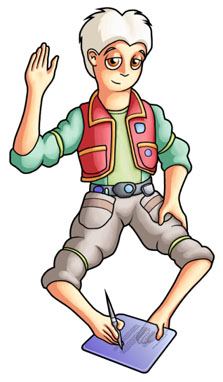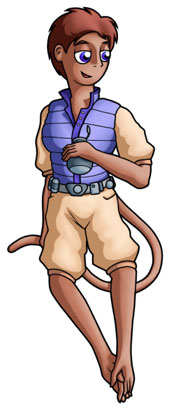Table of Contents
 Belters are a class of recoms distinct from the common “furry” recoms that live on Luna, Mars and the other colony worlds. They have their own unique background, physical traits, culture and history. They are genetically engineered to live and work in a zero-gravity environment.
Belters are a class of recoms distinct from the common “furry” recoms that live on Luna, Mars and the other colony worlds. They have their own unique background, physical traits, culture and history. They are genetically engineered to live and work in a zero-gravity environment.
History
Belter is short for “asteroid belt miner”. They were originally invented by the big mining companies during the “iridium rush” years of the 2020s. The creation of belter-type recoms and asteroid colonies inhabited by them continued for the next thirty years, right up through the outbreak of war.
Other recoms were given animal-like traits for a number of reasons: superior senses of smell, hearing, or night vision, special abilities such as flight, and the ability to survive in conditions that were not as good for humans. But there was another reason: to distinguish them visually from humans and reinforce the idea that recoms are inferior. It's easier to enslave people who don't look like you, who you consider subhuman. It also helps prevent your artificial beings escaping and hiding among the human population.
With belters it was different. They lived indoors, in a controlled environment, and didn't need fur to protect them from the elements – shed fur was simply a nuisance in asteroid colonies. The belters were all stuck on distant asteroids, far from human population centers, and their unusual body forms made it impossible to mistake them for humans anyhow. Therefore, they were never given the fur, muzzles and other typical traits of furry recoms. They have a human-like appearance overall.
When Earth was devastated by the Apocalypse War, civilization survived only in space colonies scattered around the solar system. Luna and Mars were the largest colonies, but many more were small asteroid colonies. Some of these colonies were too small to remain self-sufficient after the war and were abandoned, but many other survived. As decades passed and recom civilization recovered from the aftermath of the war, asteroid mining and colonization has begun to grow again: some abandoned colonies have been re-inhabited and new ones have been established.
Physical Description
 The belter genome runs about 97 to 98 percent the same as human DNA, which technically makes them slightly less “human” than most furry recoms, on average. However, their overall human-like appearance causes some prejudice against them. Recoms everywhere have adopted the remnants of human culture – yet humans are also remembered by some recoms as the race that enslaved them, ruined the Earth, and finally wiped themselves out. Because they find gravity unpleasant, belters don't often visit the colonies of Luna, Mars and other planets. That causes them to be rarely seen by most other types of recom, and such unfamiliarity also colors encounters between the types.
The belter genome runs about 97 to 98 percent the same as human DNA, which technically makes them slightly less “human” than most furry recoms, on average. However, their overall human-like appearance causes some prejudice against them. Recoms everywhere have adopted the remnants of human culture – yet humans are also remembered by some recoms as the race that enslaved them, ruined the Earth, and finally wiped themselves out. Because they find gravity unpleasant, belters don't often visit the colonies of Luna, Mars and other planets. That causes them to be rarely seen by most other types of recom, and such unfamiliarity also colors encounters between the types.
In addition to their human-like appearance, belters differ from furry recoms in another important way: they have no legs. Instead of legs, each belter has at least four arms and hands, and often more. This allows the belter to anchor himself with one or two handholds while using the remaining hands for work. Belters occur in a number of species, just as furry recoms do. However, instead of canines, felines, mustelids and such, belter species have various forms with different numbers of arms and other body parts. The most common species is the “quaddie” belter which appears with an second, heavy-duty pair of arms in the place of human legs. Other species include “hexies” with six arms, and some “gemini” forms in which two are conjoined in one body. Some have prehensile tails, but most belters have no tail. Belters are found in the same genders as furry recoms: female, male, hermaphrodite and the occasional androgyne.
The gemini belters are particularly distinctive. Conjoined forms are not unknown among recoms in general, but they are much more widespread among belters. These were originally designed on the theory that a conjoined form would require less resources to support than two recoms, while still being able to double-check each other and stay alert through long shifts of work. Geminis have developed their own traditions and viewpoints: their form requires them to learn the arts of cooperation and compromise to a high degree. They take pride in these skills, and feel that they exemplify the best qualities of belter society as a whole. Although conjoined furry recoms are often viewed as handicapped or freakish, gemini belters are more likely to be found among the “upper crust” of their society and are never viewed as being disadvantaged.
Aside from these visible physical traits, there are a few less obvious genetic modifications. All belters, without exception, have genes which prevent their bodies from suffering any ill effects of living without gravity. They never suffer from claustrophobia, and they have some extra resistance to radiation exposure. There are a few uncommon variants. The major belter colonies are mostly populated with human-like belters, but some small colonies are populated with furry belters. Some furry recom traits have also crept in by cross-breeding and genetic manipulation, so you might find the occasional human-like belter with feline ears and a furry tail. Another recent genetic modification is the long-necked belter, some having a flexible neck as much as a meter in length.
Movement
 Although most comfortable in zero gravity, belters are able to tolerate high acceleration for short times. Given a suitable acceleration couch, they have no problem flying on high-performance spaceships. (Long-necked belters are an exception, as they can suffer injury from high acceleration.) Moving around on a planet's surface is trickier for belters. Most feel disoriented and awkward at first, but they can adapt. Moving around usually calls for walking “quadrumanually” on four hands, preferably with gloves. Some quaddie belters can learn to walk upright on their lower pair of hands, but it takes considerable practice. None of them are really built for walking, and no amount of practice will ever give them the speed or endurance of someone with legs. For brief planetary visits, many belters would prefer to rent a motorized wheelchair or a segway-like scooter. Luna is one of the easier places for them to visit, since its gravity is relatively low.
Although most comfortable in zero gravity, belters are able to tolerate high acceleration for short times. Given a suitable acceleration couch, they have no problem flying on high-performance spaceships. (Long-necked belters are an exception, as they can suffer injury from high acceleration.) Moving around on a planet's surface is trickier for belters. Most feel disoriented and awkward at first, but they can adapt. Moving around usually calls for walking “quadrumanually” on four hands, preferably with gloves. Some quaddie belters can learn to walk upright on their lower pair of hands, but it takes considerable practice. None of them are really built for walking, and no amount of practice will ever give them the speed or endurance of someone with legs. For brief planetary visits, many belters would prefer to rent a motorized wheelchair or a segway-like scooter. Luna is one of the easier places for them to visit, since its gravity is relatively low.
On planets with forested areas, belters can learn to become excellent climbers – but, as with walking, this takes practice. Belters have no natural fear of falling, which can lead to overconfidence and a few mishaps as they learn to climb. In theory, belters should be able to swim well, but few have ever seen it done. Belters are extremely wary about open pools of water, since loose water floating around in zero gravity can be a dangerous thing. Fear of drowning (hydrophobia) and fear of wide open spaces (agoraphobia) are common problems for belters visiting a planetary surface.
Society
Belter culture has been shaped by their history and environment. They live in a naturally hostile, unforgiving environment, in closed habitats. They tend to have a strong sense of community, cooperation, organization, and a strong work ethic. They tend to be cheerful and friendly, but serious-minded about safety issues (both personal and public). They dislike conflict and are usually (but not religiously) pacifists. They like bright colors and bouncy music. They enjoy physical contact with others, and their “personal space” tends to be small – they don't mind crowding together or getting close to one another, even with strangers.
However…. They also can be cliquish, conformist, and have a strong sense of who's part of their group and who isn't. Rocking the boat is frowned upon, and the true misfit or eccentric can have a hard time getting along on a belter colony. Their society has little tolerance for crime. Although usually friendly toward outsiders, belters rarely confide in them or allow them easy entry into their organizations. They are skilled engineers, but are not known for deep thinking or inventiveness in fields of science and art. Their society on the whole is insular, and does not interact with wider society much: they trade freely with other nations in raw materials, manufactured goods and food, but rarely in entertainment, fashions, or items of popular culture.
The largest belter colony – and the third largest colony in the Solar System, after Luna and Mars – is New Philadelphia. Its tunnels are dug into the loose gravel and sand of asteroid 253 Mathilde: an irregular, carbonaceous, main-belt asteroid about 60 kilometers long. This colony is known not only as the largest asteroid colony, but also has the largest and best equipped spaceship construction yard in known space. It can build and modify ships up to the largest class 5, including ships that are unable to enter atmosphere or land on any planetary surface. Skilled belter workers, with free-floating access to all parts of the ship, are able to make ship repairs more quickly than at any other shipyard. However….. They do not sell weapons or ammunition, nor will they service ships matching known configurations of ships reported missing/stolen, as this is against the colony's policies.
